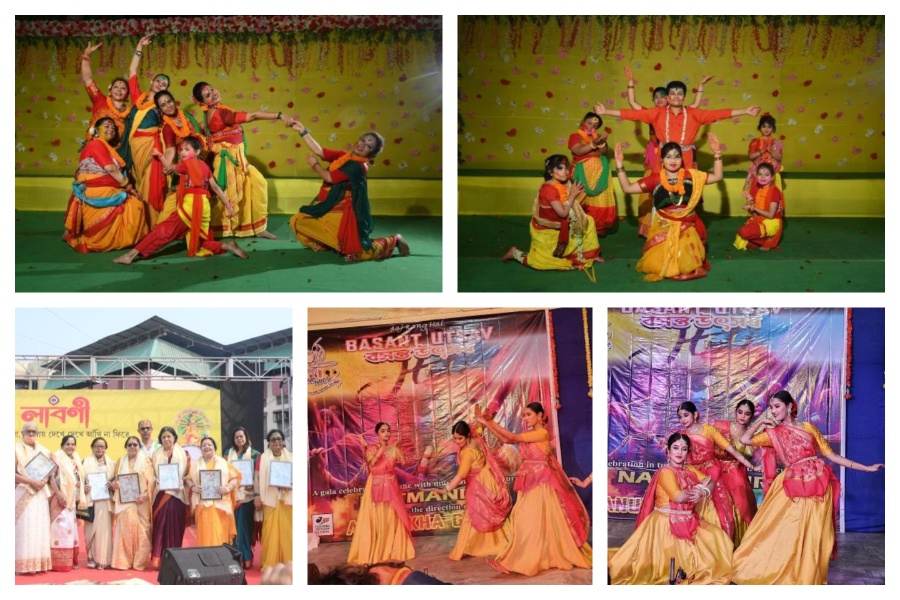FD Block
Residents of FD Block ignored the sweltering afternoon heat last Sunday to celebrate spring in the evening, as a pleasant breeze wafted across the low stage erected next to a tree with red blooms in the park.
“We want to follow the Santiniketan style of Basanta Utsav. So we chose the closest substitute we have for palash flowers to build the stage by. In fact, had the ground been even, we would have dispensed with any kind of stage,” said block secretary Abhijit Majumdar.
The 90-minute show had singers seated on the ground on one side and dancers on another, awaiting their turn to take the stage. There were 20 singers in all, with a heavily skewed gender ratio, who presented the opening song Ore Grihabasi in chorus. “It is becoming increasingly challenging to find male singers,” admitted Majumdar, who sang, along with neighbour Jayanta Kanjilal, with 18 female singers.
The songs, punctuated by recitations by Susanta Gupta, Pompiya Basu Nath, Sonali Das and Madhumita Bhattacharya, were mostly in chorus. Kanjilal presented a duet, Ami pathbhola ek pathik, along with Mrittika Roy. The other duet song, Akash amay bhorlo aloy, was sung by Majumdar and his daughter Sampreena, who also sang Aha aji e basante solo. Ananya Biswas was the other solo artist, with her recital of O amar chander alo.
Majumdar, a disciple of Rabindrasangeet veteran Ashish Bhattacharya, highlighted another issue — the dearth of young faces in block programmes. “Even 10 years ago, the block would be abuzz every time something was planned. Now there are barely two or three young faces. The rest of us are all senior citizens,” he lamented.
The dancers numbered 37, ranging from youngsters like Sukatha Chakraborty, Akash Mukherjee, Sumedha Sanyal, Toshani Das and Amarissa Hartmann, aged around eight years, to Mita Majumdar, a senior citizen.
There were even younger ones, aged three to four and half years. “They were supposed to have led the dancers at the start of the opening song but the bright lights and the unfamiliar faces must have scared them. The three tots started crying as soon as their mothers left their sides,” said Sonali Das, who conceptualised the show.
The choreography was done by her daughter Sohini Das Hartmann, currently a Dhaka resident. “She taught the group over video clips and flew over four days before the show for rehearsals,” Sonali said.
The programme was followed by a dinner of radhaballavi-chholar dal.
CB Block
Several residents of CB Block ignored the lure of the opening ceremony of the Indian Premier League and flocked to their community hall in the evening on March 22. The occasion was a Basanta Utsab organised by the CB Block Welfare Association along with block resident and dancer Anurekha Ghosh and her students under the banner of Natmandir.
“Natmandir is more of a gurukul than a dance school as we train students for long periods and hold their hand as they step into the world of professional dancing,” said Ghosh, of the institute that teaches kathak, Rabindra Nritya and folk dance, the three sections that the evening’s presentation was divided into.
There were three guest artistes as Natmandir also provides a platform to outside talent. Anindita Bose recited Tagore’s Abhisar to the strains of sarod played by Sunando Mukhopadhyay, young Sudipta Bhattacharya danced kathak and Angshika Das performed Rabindra Nritya to E ki labonye purno pran.
While Ghosh presented a kathak recital with a sufi touch, dancing to a bandish by Hazrat Amir Khusrau, she also recited the bol with lines on spring for five of her students to dance to.
The programme started with a felicitation of councillors Rajesh Chirimar and Ranjan Poddar, and block president Nitish Chakraborty.
An item that brought a smile to every face was the opening act of nine tots swaying to Aha aji e basante. “We rehearsed for three days,” said eight-year-old Adriti Dutta, who had come with her mother from Hatibagan. Angshika Poddar of Karunamoyee too was part of the group. The five-year-old loves dance, so her family had stayed on even after her performance. This meant her uncle Anjan made his way out and switched on his mobile to watch the IPL action on the phone screen. “Wish her programme had been on some other day,” he admitted.
The phone was also streaming the match for the block’s electrician Badal Sen. “It’s our city team (Kolkata Knight Riders) playing, so it’s a must-watch game,” said Sen.
But there were several residents like Koushik Basu for whom cricket took a backseat. “We chose this date after the original date had to be rescheduled. Some residents did remind us about the IPL opening but such programmes have their own pull in our block. See the attendance,” he said, pointing to the near-capacity crowd.
In fact, the footfall has made the organiser Anurekha Ghosh consider shifting the venue next year from the block community hall to an auditorium and hold it on a bigger scale. “I am a Salt Lake resident since 1981. This Basanta Utsav is Natmandir’s gift to my neighbours. Most of my shows happen in Calcutta, away from them. But this spring festival will always be held in the township,” she said.
Labony Abasan
Labony Abasan, which celebrated its 50th Durga puja last autumn, continued the golden jubilee celebration by organising Basanta Utsav on the grandest scale ever.
It was a four-and-half hour programme featuring song, dance and recitation by residents. An ENT specialist, Manas Gupta, also played the violin. But the highlight was a felicitation of 50 residents. “We wanted to thank the people who have been working for our puja almost since the start,” said secretary Sumit Sarkar, who was eight years old when the first Durga puja took place. “In those days, Salt Lake used to plunge into darkness once the sun set. There were just 32 families settled in Labony,” he recalled.
Sikha Dasgupta, the senior-most among the Puja volunteers, was too unwell to make it and had her gift sent over. Shibani Bagchi, 78, was among the eldest to attend. “I have been working for the puja ever since the start, along with Bithika Banerjee and Swapna Chakraborty. We would cook the bhog while Sikhadi would chop fruits and help the priest,” she recalled.










